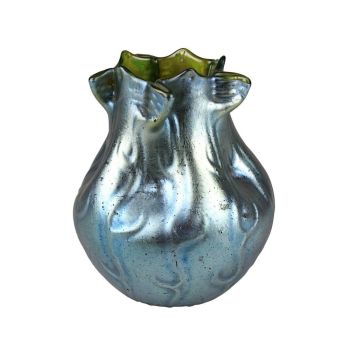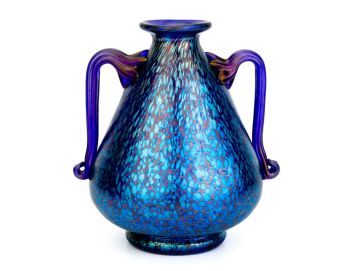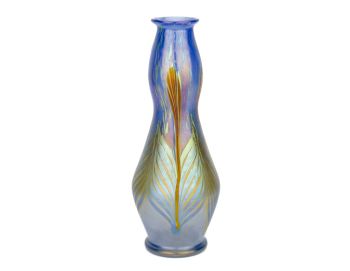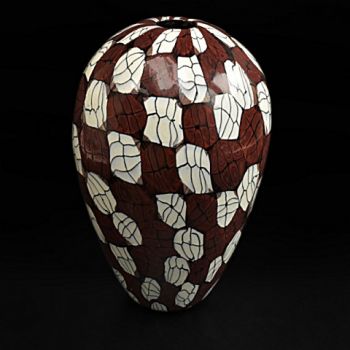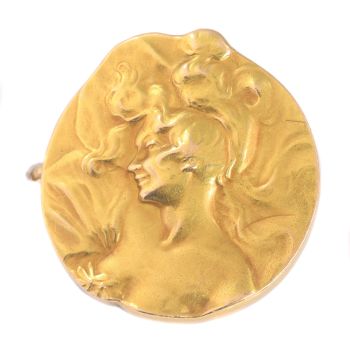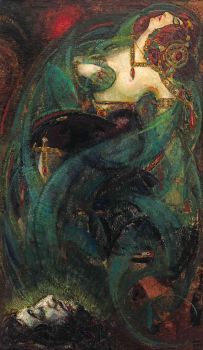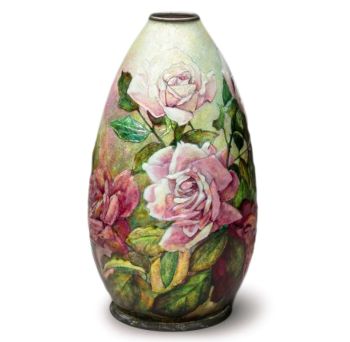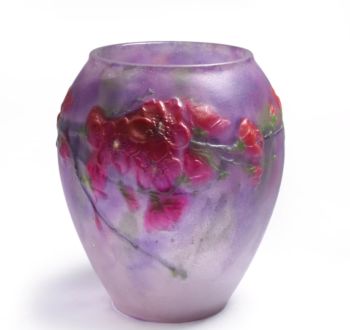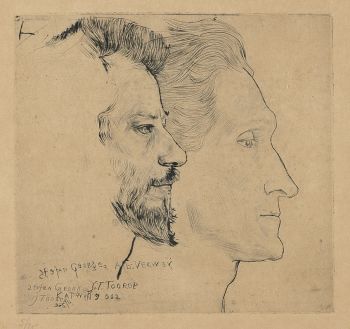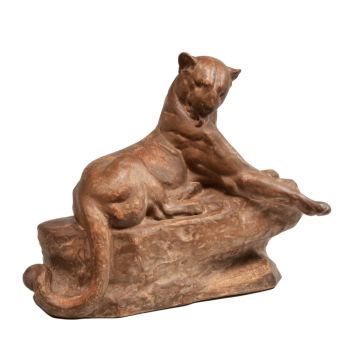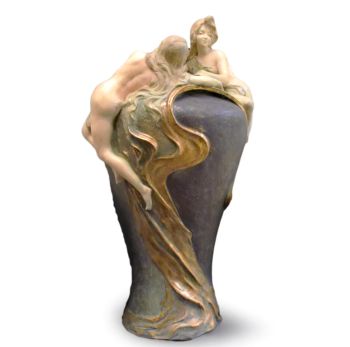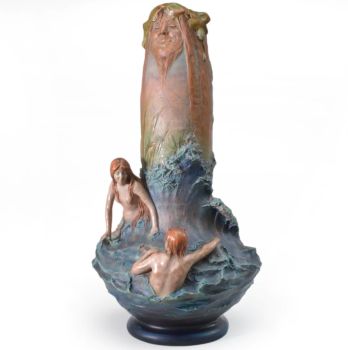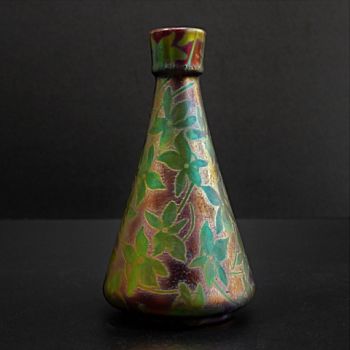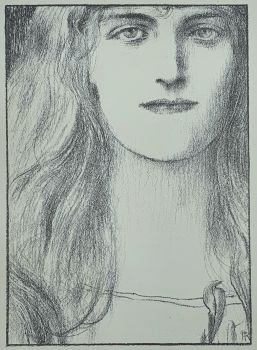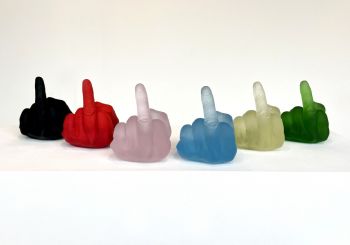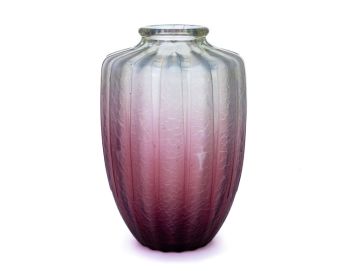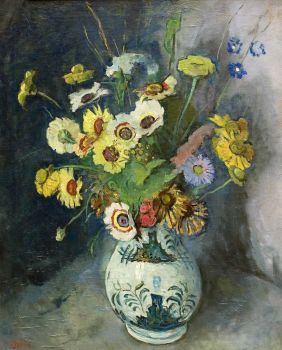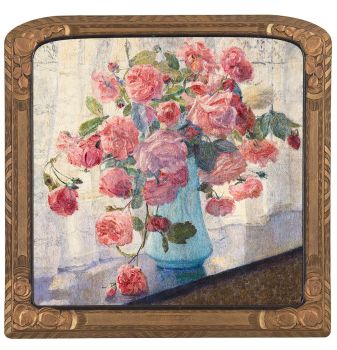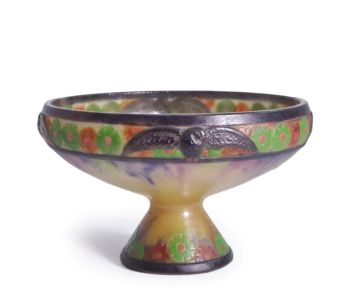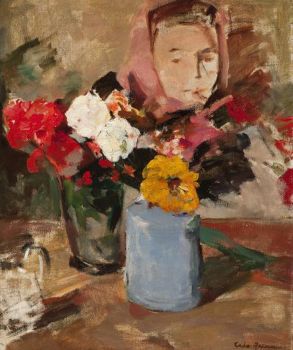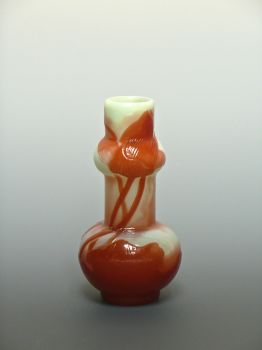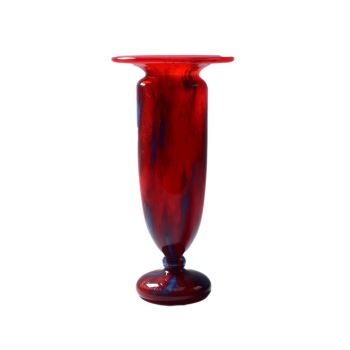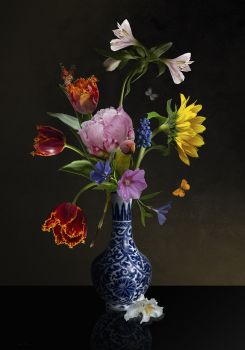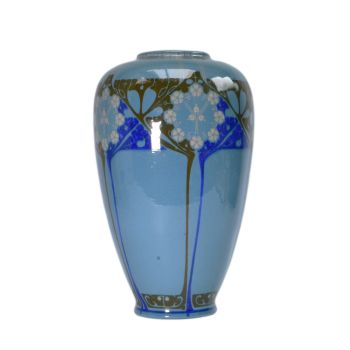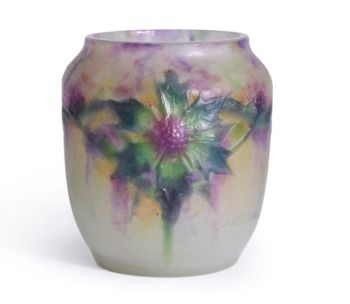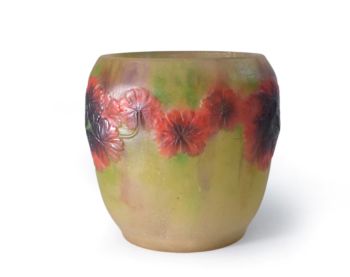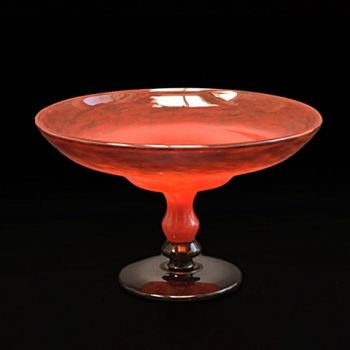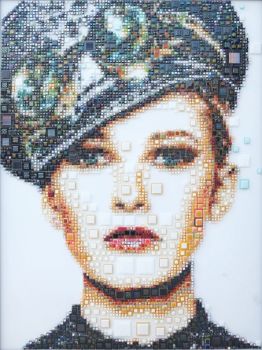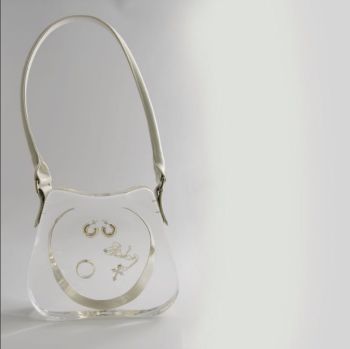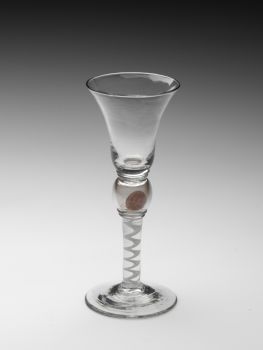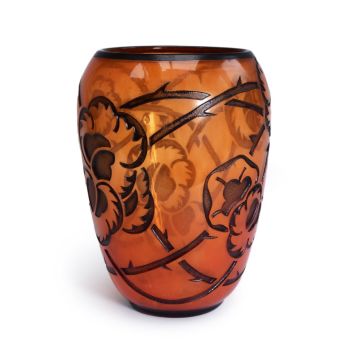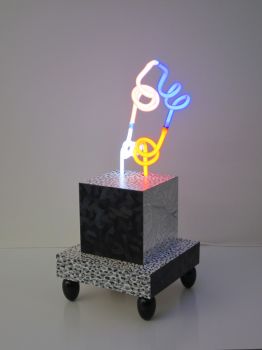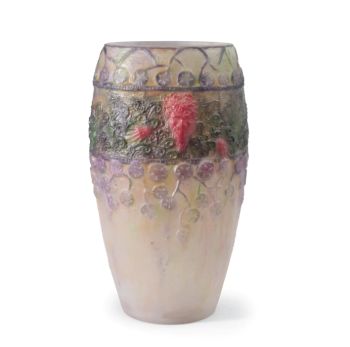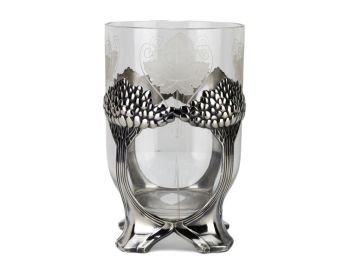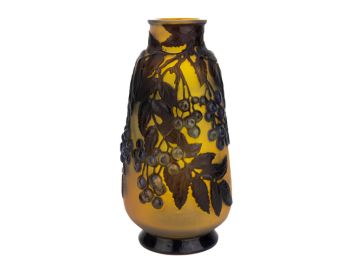Johann Loetz Witwe – “Zebra” decor, designed by Koloman Moser for E. Bakalowits – 1903 1903
Johann Loetz (Lötz) Witwe Klostermühle
Bicchiere
8 cm, ø 7 cm
ConditionMint
Prezzo su richiesta
Antiques Emporium
- A proposito di opere d'arteIntroducing a rare and captivating piece by Johann Loetz Witwe, featuring the exceptionally rare Zebra decor, designed by the renowned Koloman Moser in 1903 for E. Bakalowits, Vienna. This exquisite vase/cup is a true testament to the artistic brilliance and innovative craftsmanship of the early 20th century.
The Zebra decor is a distinctive and highly sought-after pattern, characterized by its striking black and white or contrasting dark and light bands that mimic the natural beauty of zebra stripes. The intricate glasswork and iridescent finish highlight the exceptional skill and artistry of Loetz glassmakers.
Koloman Moser, a pivotal figure in the Vienna Secession movement, designed the Zebra decor in 1903. Moser was instrumental in shaping modern design, blending artistic creativity with functional elegance. His work in 1903 was marked by groundbreaking designs that pushed the boundaries of traditional decorative arts.
This vase/cup is not just a decorative item but a piece of history. In 1903, Moser’s designs were revolutionizing interiors, moving towards modern, geometric styles that emphasized simplicity and elegance. His collaboration with Loetz and E. Bakalowits resulted in pieces that were both artistic and commercially successful, appealing to the discerning tastes of the time.
Koloman Moser (1868-1918) was one of the foremost designers of the Vienna Secession, a movement that sought to break away from the historical emphasis on traditional styles. In 1903, Moser was at the height of his career, creating innovative designs that were both functional and aesthetically pleasing. His work during this period included not only glassware but also furniture, textiles, and entire interior designs, showcasing his versatile talent and visionary approach.
This vase/cup, with its Zebra decor, is an excellent addition to any modern interior. Its bold pattern and elegant form make it a striking centerpiece, whether displayed on its own or as part of a collection. The piece reflects the transition towards modern design principles that Moser championed, making it both a timeless and contemporary artifact.
Dimensions:
Height: 88mm / 3.46”
Diameter top: 75mm / 2.95”
Diameter base: 65mm / 2.56″
Condition: Mint
Literature:
Hatje Cantz – Loetz Bohemian Glass 1880 – 1940 – Page 159, 160 & 316.
Prestel – Böhmisch Glas 1880 – 1940 Band 1 Werkmonographie – Page 172, 173, 178 & 340 . - A proposito di opere artista
La vetreria Loetz esisteva a Klostermuhle, in Austria, da poco più di cento anni, a partire dal 1840. Ma il suo periodo di massimo splendore fu durante la vita di Max Ritter Von Spaun, nipote dell'originale Johann Loetz che aveva fondato l'azienda.
Von Spaun rilevò l'azienda nel 1879 e la diresse fino al 1908, un anno prima della sua morte. Fu assistito da Eduard Prochaska, suo tecnico specialista, e insieme inventarono, progettarono e produssero tutta una serie di meravigliosi nuovi tipi di vetro, ottenendo numerosi brevetti e vincendo premi in tutte le maggiori esposizioni mondiali durante gli anni 1890 e i primi anni del il nuovo secolo.
L'azienda Loetz era tra i leader nel design Art Nouveau e in particolare nel vetro artistico iridescente. Il vetro "Papillon", come il vaso a sinistra, è talvolta noto oggi come vetro "macchia d'olio". Un'altra colorazione preferita di Loetz era il vetro irridizzato con scie tirate chiamato vetro "Fenomeno".
C'erano vasi irrigiati con nastri di colori metallici che si snodavano sulla superficie, e molti disegni spettacolari con scie applicate di bellissimi colori, o semplicemente tirati fuori dal corpo del vetro per formare maniglie o decorazioni.
Intorno al 1900 l'azienda iniziò a collaborare con designer esterni e alcuni grandi artisti disegnarono pezzi per Lotz, in particolare Joseph Hofmann, Koloman Moser, Maria Kirchner e Hofstatter.
Nel 1908 Loetz fu rilevata dal figlio di Max Von Spaun, anche lui chiamato Max, e sebbene stentasse finanziariamente (fallendo nel 1911 e di nuovo nel 1931) ci furono diversi grandi designer il cui lavoro fu prodotto da Loetz in quegli anni e attraverso l'arte periodo déco. Questi includevano Adolf Beckert e Michael Powolny.
Sei interessato ad acquistare questa opera d'arte?
Artwork details
Related artworks
Johann Loetz (Lötz) Witwe Klostermühle
Johann Loetz Witwe - Phänomen Genre 7773 – Orange1900 - 1910
Prezzo su richiestaAntiques Emporium
Johann Loetz (Lötz) Witwe Klostermühle
Johann Loetz Witwe – Ausfuehrung 146 Titania vase – 19121910 - 1919
Prezzo su richiestaAntiques Emporium
Johann Loetz (Lötz) Witwe Klostermühle
Johann Loetz Witwe – Jugendstil Cobalt Papillon vaas1900 - 1910
Prezzo su richiestaAntiques Emporium
Johann Loetz (Lötz) Witwe Klostermühle
Johann Loetz Witwe – Phänomen Genre vaas in blauw opaal – 19021902 - 1903
Prezzo su richiestaAntiques Emporium
1 - 4 / 7Frères Daum
Daum Nancy – “Paysage Soleil Couchant” vase with two applied handles1900 - 1910
Prezzo su richiestaAntiques Emporium
Artista Sconosciuto
François-Théodore Legras – Tall “Fleurs de Pommier” apple blossoms vase1900 - 1909
Prezzo su richiestaAntiques Emporium
Johann Loetz (Lötz) Witwe Klostermühle
Johann Loetz Witwe – Ausfuehrung 146 Titania vase – 19121910 - 1919
Prezzo su richiestaAntiques Emporium
1 - 4 / 24Demetre Chiparus
Demetre H. Chiparus – Bronze Art Deco statue “Rapture” – Édition Etling, Paris1920 - 1929
Prezzo su richiestaAntiques Emporium
Amalric Walter
Amalric Walter & Henri Bergé – Crabe plumier1920 - 1929
Prezzo su richiestaAntiques Emporium
Johann Loetz (Lötz) Witwe Klostermühle
Johann Loetz Witwe – Ausfuehrung 146 Titania vase – 19121910 - 1919
Prezzo su richiestaAntiques Emporium
Frères Daum
Daum Nancy – “Paysage Soleil Couchant” vase with two applied handles1900 - 1910
Prezzo su richiestaAntiques Emporium
1 - 4 / 24Coba Ritsema
Two vases with flowers and a portrait1900 - 1950
Prezzo su richiestaKunsthandel Pygmalion
Daum Nancy
Daum Nancy – Tall rare early Art Nouveau vase executed in “Cygnes (swans)” motif – Circa 18921890 - 1899
Prezzo su richiestaAntiques Emporium
1 - 4 / 24Artista Sconosciuto
François-Théodore Legras – Tall “Fleurs de Pommier” apple blossoms vase1900 - 1909
Prezzo su richiestaAntiques Emporium
Artista Sconosciuto
EIGHT NEO-GOTHIC STAINED GLASS WINDOWS WITH SUSPENSION EYELET, 19th C, BELGIUM.1850 - 1900
Prezzo su richiestaSpectandum Gallery
Artista Sconosciuto
Un gobelet anglais-néerlandais1738
Prezzo su richiestaPeter Korf de Gidts - Antiquairs
Johann Loetz (Lötz) Witwe Klostermühle
Johann Loetz Witwe – Ausfuehrung 146 Titania vase – 19121910 - 1919
Prezzo su richiestaAntiques Emporium
1 - 4 / 24Johann Loetz (Lötz) Witwe Klostermühle
Johann Loetz Witwe – Jugendstil Cobalt Papillon vaas1900 - 1910
Prezzo su richiestaAntiques Emporium
Johann Loetz (Lötz) Witwe Klostermühle
Johann Loetz Witwe – Ausfuehrung 146 Titania vase – 19121910 - 1919
Prezzo su richiestaAntiques Emporium
Amalric Walter
Amalric Walter & Henri Bergé – Crabe plumier1920 - 1929
Prezzo su richiestaAntiques Emporium
Gabriel Argy-Rousseau
Gabriël Argy-Rousseau – Crabes et Algues vase – 19201920 - 1929
Prezzo su richiestaAntiques Emporium
Johann Loetz (Lötz) Witwe Klostermühle
Johann Loetz Witwe - Phänomen Genre 7773 – Orange1900 - 1910
Prezzo su richiestaAntiques Emporium
Johann Loetz (Lötz) Witwe Klostermühle
Johann Loetz Witwe – Phänomen Genre vaas in blauw opaal – 19021902 - 1903
Prezzo su richiestaAntiques Emporium
1 - 4 / 12













